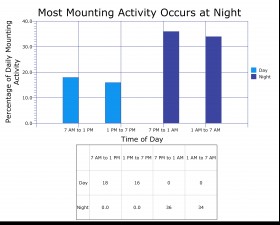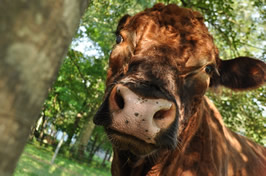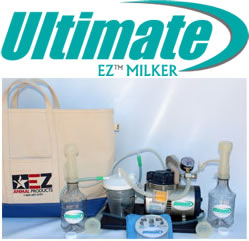It is an important tool to know the signs of estrous (heat) in cattle. For people who artificially inseminate (A.I.) their cows, or take their cows to be bred, this information is invaluable. However, it may also be useful to those who keep their cows with a bull, as it allows you to establish a likely breeding date, and determine that a cow is, in fact, cycling.
The average estrous cycle is 21 days, meaning a cow will exhibit signs of heat and be receptive to a bull about every 21 days. This cycle length will vary between animals and between seasons, with winter cycle lengths being longer, and summer being shorter. The range is about 18-23 days.
Since Dexters are often not as demonstrative as some other breeds, their signs of estrous may be more subtle, and the classic “bellowing at the gate” that all the old-timers tell you to look for, may simply not occur.
Here are some other signs to look for:
Signs a cow is coming into heat:
An early sign may be that the cow is restless, and is standing up and twitching her tail, while her herdmates are lying down.
As the cycle progresses, she will try to mount other cows, but will not stand to let them mount her, and will turn around and butt them. Her vulva may appear somewhat swollen
She may act differently than she does normally. Perhaps snorty or spooky, perhaps extra friendly and clingy or just very playful. This can be towards you or other cows.
Standing Heat:
Standing heat is the receptive period of heat, when the cow would stand to be bred by a bull. This lasts for up to 18 hours.
At this point, a cow now stands to be mounted by another cow. She may slowly walk away, but she will not turn and butt the other cow. She will be mounted several times an hour.
You may see clear, watery mucus discharge from the vulva.
Some cows will eat less or produce less milk, but this is variable
Signs a cow is coming out of heat:
Cow no longer stands to be ridden. Although you may see her mounting another cow that has come into heat.
Hair on the tail head may be worn from other cows mounting her.
You may see smudges of dried mucus on her tail or thighs
2-3 days later you may notice a slight bloody discharge. This is normal and appears regardless of if the cow conceived during the cycle.
Now, here is the tricky part. Most mounting activity occurs at night (See Table 1). So, you really need to observe your animals morning and evening, to get an idea what they were up to under the cover of darkness. (Or you can get yourself some infarred glasses and set up camp.)
When cattle are being bred A.I., it is common for breeders to desire a predictable estrous cycle, and to have several animals experience synchronized cycles. There are injections and implants that, used according to a system, will make most of your animals cycle at nearly the same time. These systems should be used under the supervision of an A.I. technician or veterinarian. However, this does not completely relieve you of heat detection duty.
There are some great products that are designed to help us catch cows in heat. One is the heat detection patch, which is applied on to the top of the tail head. This patch will be damaged when the cow mounted, and it will change color indicating you’ve missed some action. http://www.jefferspet.com/kamar-heatmount-detectors/camid/LIV/cp/16361/ There is also chalk or a grease pen that can be obtained through catalogs or at some feed stores. Apply a solid stripe down the tail head and if it’s rubbed off you missed some action. http://www.jefferspet.com/all-weather-twist-stick-livestock-marker/camid/LIV/cp/L2-M5/ You can also use florescent spray paint from your local hardware store.
There is also electronic heat detection. An electronic heat detector is placed in a special pouch and glued to the cow’s back. Information about the duration and frequency of mounting activity is registered, giving the technician an accurate assessment of when the cow was in the peak of her estrous cycle. Although the cost of this system makes it impractical for most small Dexter herds, it is available at many A.I. centers. For a nominal fee, your cows can be taken to the A.I. center and enrolled in the heat detection system. The technician will gather the information on their cycles and they will be artificially inseminated at exactly the right time.
Timing is critical for artificial insemination. Many Dexter breeders actually drop their cows off at an A.I. center or the veterinarian’s office for proper heat detection, just to insure the highest success rate. This is something to consider, if you are not home enough for proper heat detection, as you don’t want to waste time and straws. The problem with this may be if the cows lose weight at the center because of changes in feed. A cow should be gaining weight, (not losing) to maximize conception rate. You can reduce this risk by bringing your own feed, or discussing your cow’s feed routine with the person who will be caring for her.
For those who have a veterinarian or A.I. tech come to the farm, he or she will give you the specifics for the system or protocol they are using. They will generally want to A.I. the cow 12-24 hours after the first instance of standing heat (which is approximately when she ovulates). If you are using sexed semen, you might want to provide this link to your vet or tech, as they may not know that sexed semen is supposed to be used on the later end of the breeding window. https://beefrepro.org/wp-content/uploads/2021/01/Sexed-Semen-Protocols-for-Sire-Directories-2021.pdf



